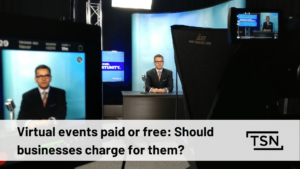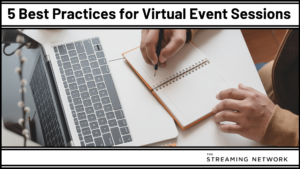More and more businesses are learning how to host a podcast and realizing there are many benefits that come with it. It has quickly evolved from a consumer-targeted medium to business-focused thought leadership program.
Companies across a range of sectors are putting marketing dollars into backing podcasts in exchange for pre-roll mentions, logo placement and host endorsements (Slack Variety Pack, GE’s The Message). Businesses are also putting more money into also to creating their own in-house productions.
In the B2B space, there has been a surge of companies disseminating their own thought leadership through podcasts as part of demand generation strategies.
If you’re just starting out, I encourage you to read our 8 Week Guide For Planning A Webinar, to help you understand the planning process prior to the hosting process.
Hosting A Corporate (B2B) Podcast – 10 Tips
One of the biggest challenges businesses face is how to turn their corporate leaders into podcast hosts. The complexity of hiring a professional host who doesn’t understand the business must be balanced against using internal resources who understand client needs and the direction of the market far better and can be engaged in more robust conversations.
We chose the latter for our own internal podcast, The Webinar: Lessons From the Front Line. For those choosing this kind of DIY approach, I’ve learned a lot in the past year of production.
To help break down some of these complexities, I’ve put together 10 tips to help you develop your skills as a podcast host.
1. Keep It Conversational
You want to create a conversation, and you want that conversation to feel natural as if it is happening for the first time. You don’t want people reading from a script.
Guests should know what you’re covering, but it’s better to have it written out in point form than to have everything written out. Nothing destroys the feeling of a natural conversation like someone reading from their notes.
2. Know Your Audience
Create a persona of your target audience member. Know who you are targeting.
Ask yourself a few questions:
- What are his or her interests outside of work?
- What is his or her job function?
- Why is he or she listening to this podcast?
It’s good to remember that podcast audiences tend to skew towards the younger demographic, so less formality may be a good approach.
3. Conduct Pre-Interviews
Don’t run through the entire show because you risk leaving your best material in the rehearsal. However, you should get everyone together either on the phone or, preferably, in a room together and discuss who will cover what.
If you know where it is heading, pre-interviews will help you as the host be able to guide or appear to guide, the conversation.
4. Come with Prepared Questions
You should have about 6 to 10 questions in your back pocket that you will either use because they are essential to the narrative, or as a fallback, in case the conversation grinds to a halt.
You don’t need to know the subject you were covering in-depth, but you should know the key points that you need to cover and prepare questions that will address each of those key points, plus follow-ups
5. Make Guests Feel at Ease
Guests may be nervous. Maintain eye contact and nod your head to convey that you are following. Try to avoid saying “Ya” to express that you get it. A simple nod will suffice.
6. Keep It Light
Remember your audience and speak to them. You are trying to inform, but this is an entertainment medium. Introduce banter if appropriate. If you are co-hosting, then some easy banter between the hosts can go a long way.
It engages your audience and makes them feel as if they are part of a conversation.
7. Keep It Tight
You want to make sure that answers and questions are tight. What you don’t want is to ask a question and then have one of your guests speak for five straight minutes. People get bored when there is too much information thrown their way.
If a guest is going on about something, don’t feel bad about interrupting them and moving the conversation forward. That’s your job as a host. You can do this gently and politely.
Let them know prior to the podcast that if they are going on too long you will give them a sign like holding up your index finger, and as soon as you can, interject. Put yourself in the audience shoes and imagine how they are hearing the subject.
If the point being made requires a lengthy discussion, then break it down and add some back and forth either between you and the guest, or a second guest. Break the information up by adding in stories, personal anecdotes, or something for your audience to relate to.
The host should continue to interject and appear to lead or participate in the conversation.
8. Engage Your Audience in Conversation
Speak to your audience like they are in the room with you and think of them as a third person listening to your conversation—not a crowd of people listening to your conversation.
This creates a one-on-one feel, inviting them into the conversation with you to go on the journey together.
9. Show Appreciation
Always be gracious and give of yourself the way you want your guests to give. Add your personality to the mix and be authentic. This helps form a connection with your audience, which shows appreciation to the listeners as well.
10. Fix It in Post
There is much we can do in the edit suite to iron out rough edges. Let guests know at the outset that if they are on her unhappy with their answer, they can go back and try it again. This will go a long way to putting them at ease.
Let’s Recap: How To Host A Podcast
- Businesses are seeing and embracing the benefits of podcasts: If your business hasn’t yet, it’s time to look at the numbers.
- Always remember your audience: That’s why many of the above 10 tips are based around your audience and their needs.
- Rehearsals are key but don’t sound pre-rehearsed: Remember that nothing destroys the feeling of a natural conversation like someone reading from their notes.
- Try to have some fun!: When appropriate, add some banter, stories, personal anecdotes, or something for your audience to relate to.
Need help with planning and hosting a webinar? Our expert webinar team is always available to help out. Reach out to our team today.






